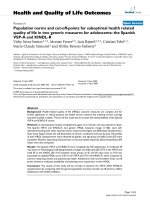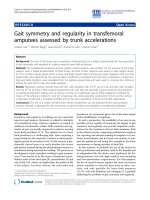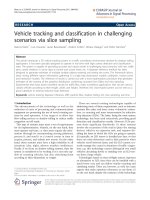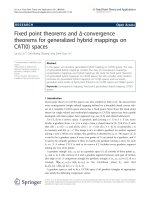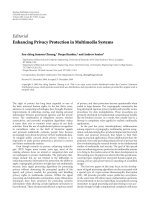Báo cáo hóa học: " FIXED POINTS AND CONTROLLABILITY IN DELAY SYSTEMS" potx
Bạn đang xem bản rút gọn của tài liệu. Xem và tải ngay bản đầy đủ của tài liệu tại đây (552.03 KB, 14 trang )
FIXED POINTS AND CONTROLLABILITY IN DELAY SYSTEMS
HANG GAO AND BO ZHANG
Received 9 December 2004; Revised 28 June 2005; Accepted 6 July 2005
Schaefer’s fixed point theorem is used to study the controllability in an infinite delay sys-
tem x
(t) = G(t,x
t
)+(Bu)(t). A compact map or homotopy is constr u cted enabling us to
show that if there is an aprioribound on all possible solutions of the companion control
system x
(t) = λ[G(t,x
t
)+(Bu)(t)], 0 <λ<1, then there exists a solution for λ = 1. The
aprioribound is established by means of a Liapunov functional or applying an integral
inequality. Applications to integral control systems are given to illustrate the approach.
Copyright © 2006 H. Gao and B. Zhang. This is an open access article distr ibuted under
the Creative Commons Attribution License, which permits unrestricted use, distribution,
and reproduction in any medium, provided the original work is properly cited.
1. Introduction
This paper is concerned with the problem of controllability in an infinity delay system
x
(t) = G
t,x
t
+(Bu)(t), t ∈ J = [0,b], (1.1)
where x(t)
∈ R
n
, x
t
(θ) = x(t + θ)for−∞ <θ≤ 0, u(t), the control, is a real m-vector
valued function on J, B is a bounded linear operator acting on u,andG is defined on
J
× C with C being the Banach space of bounded continuous functions φ :(−∞,0] → R
n
with the supremum norm |·|
C
.
The problem of controllability in delay systems has been the subject of extensive inves-
tigations by many scientists and researchers for over half of a century. A large number of
applications have appeared in biology, medicine, economics, engineering, and informa-
tion technology. Many actual systems have the property of “after-effect,” that is, the future
state depends not only on the present, but also on the past history. It is well-known that
such a delay factor, when properly controlled, can essentially improve system’s qualitative
and quantitative characteristics in many aspects. For historical background and discus-
sion of applications, we refer the reader to the work of Balachandran and Sakthivel [1],
Chukwu [4], G
´
orniewicz and Nistri [8], and references therein.
Hindawi Publishing Corporation
Fixed Point Theory and Applications
Volume 2006, Article ID 41480, Pages 1–14
DOI 10.1155/FPTA/2006/41480
2 Fixed points and controllability in delay systems
Equation (1.1) describes the state of a system (physical, chemical, economic, etc.)
whose evolution in time t is governed by G(t,x
t
)+(Bu)(t). In general, we view a solu-
tion of (1.1)asafunctionofu(t) so that the behavior of the s ystem depends on (or is
controlled by) the choice of u within a set U given in advance. Assume that two states
of the system are given, one to be considered as an initial state φ, and the other as a final
state γ. The problem of controllability is to determine whether there are available controls
which can transfer the state x from φ to γ along a solution (1.1), that is, whether there
exists a u
0
∈ U such that
˙
x(t) = G(t,x
t
)+Bu
0
(t) has a solution joining φ and γ.When
this is possible for arbitrary choice of φ and γ, we can say, roughly speaking, that system
(1.1) is controllable by means of U.
The main method of proving controllability has been to w rite (1.1)asanintegralequa-
tion
x(t)
= x
0
+
t
0
G
s,x
s
+ Bu(s)
ds (1.2)
viewing the right-hand side as a mapping Px on an appropriate space, when u is properly
chosen in terms of x. Then, apply a fixed point theorem, say Schauder’s, to the mapping
P when P : K
→ K is compact for a closed, convex subset K of a Banach space. However,
P, in general, does not satisfy this condition unless the growth of G(t,x
t
)inx is restricted.
This presents a significant challenge to investigators. A modern approach to such a prob-
lem is to use topological degree or transversality method (see G
´
orniewicz and Nistri [8]).
Here we will use a fixed point theorem of Schaefer [12] which is a variant of the nonlinear
alternative of Leray-Schauder degree theory, but much easier to use.
The paper is organized as follows. In Section 2, we prove our main result on controlla-
bility of (1.1). Applications to specific systems are given in Section 3 which also contains
some general results and remarks concerning the approach.
2. Controllability
We start this section with some descriptions of spaces associated with our discussion. Let
R
= (−∞,∞), R
−
= (−∞,0], and R
+
= [0,∞), respectively, and |·|denote the Euclidean
norm in R
n
.Forann × n matrix A = (a
ij
)
n×n
,defineA=sup
|x|≤1
|Ax|. We denote by
C(X,Y) the set of bounded continuous functions φ : X
→ Y for normed spaces X and Y.
For J given in (1.1), we define C
0
={φ ∈ C(J,R
n
):φ(0) = 0} with the supremum norm
|·|
C
0
,andsetC
0
(μ) ={φ ∈ C
0
: |φ|
C
0
≤ μ}.LetL
2
(J) denote the Banach space of square
Lebesgue integrable functions x : J
→ R
n
with the norm |x|
2
= (
J
|x(s)|
2
ds)
1/2
with the
understanding x
= 0 ∈ L
2
(J)ifandonlyifx(t) = 0a.e.onJ. We denote by U the space of
admissible controls and choose U as a complete subspace of L
2
(J)withanorm|·|
U
.The
symbol
·is reserved for the norm of a linear operator.
We assume that B : U
→ L
2
(J) is a bounded linear operator. For a given u ∈ U,wesay
that x :(
−∞,b] → R
n
is a solution x = x(t,φ)of(1.1)onJ with initial function φ if x is
absolutely continuous on J and satisfies
x
(t) = G
t,x
t
+(Bu)(t), a.e. t ∈ J = [0,b] (2.1)
with x
0
= φ, that is, x(s) = φ(s)foralls ∈ R
−
.
H. Gao and B. Zhang 3
Our result rests on a fixed point theorem of Schaefer [12]. Its relation to Leray-
Schauder degree theorem is explained in Smart [13, p age 29]. Schaefer’s theorem has
been used in a variet y of areas in differential equations and control theory (see Burton
[2], Burton and Zhang [3], Balachandran and Sakthivel [1]).
Theorem 2.1 (Schaefer). Let V beanormedspace,F a c ontinuous mapping of V into V
which is compact on each bounded subset of V. Then either
(i) the equation x
= λF(x) has a solution for λ = 1,or
(ii) the set of all such solutions x,for0 <λ<1, is unbounded.
If we view U
λ
(x) = λF(x) in Schaefer’s theorem as a homotopy, then it can be restated
in the form of Leray-Schauder Principle (cf. Zeidler [14, page 245]), which is often used
in application.
Definit ion 2.2. System (1.1)issaidtobecontrollableontheintervalJ if for each φ
∈ C
and γ
∈ R
n
, there exists a control u ∈ U such that the solution x(t) = x(t,φ)of(1.1)
satisfies x(b)
= γ.
Throughout this paper, we let φ
∈ C and γ ∈ R
n
be arbitrary, but fixed. For each y ∈
C
0
,wedefine
¯
y(t)
=
⎧
⎨
⎩
y(t)+φ(0) t ∈ J,
φ(t) t
∈ R
−
.
(2.2)
This implies that
¯
y
0
= φ; that is,
¯
y(s) = φ(s)foralls ∈ R
−
. For each continuous function
z :(
−∞,b] → R with z
0
= φ,wedefine
[z]
= γ − φ(0) −
J
G
s,z
s
ds. (2.3)
We now introduce a companion to (1.1)
x
(t) = λ
G
t,x
t
+(Bu)(t)
,a.e.t ∈ J = [0,b](1.1
λ
)
for λ
∈ [0,1] and make the following assumptions.
(H
1
) The linear operator T : U → R
n
defined by
T(u)
=
J
Bu(s)ds (2.4)
is invertible; that is, for each α
∈ R
n
, there exists a unique u
α
∈ U such that
α
=
J
(Bu
α
)(s)ds.
(H
2
)Foreachy ∈ C
0
, G(s,
¯
y
s
)isLebesguemeasurableins on J,andforeachμ>0,
there exists an integrable function M
μ
: J → R
+
such that |G(s,
¯
y
s
)|≤M
μ
(s)foralls ∈ J
whenever y
∈ C
0
(μ).
(H
3
)Foranyε>0andy ∈ C
0
, there exists a δ>0suchthat[x ∈ C
0
, |x − y|
C
0
<δ],
imply
J
G
s,
¯
x
s
−
G
s,
¯
y
s
ds<ε. (2.5)
4 Fixed points and controllability in delay systems
(H
4
)Foreachφ ∈ C and γ ∈ R
n
, there exists a constant L = L(φ, γ) > 0suchthat
|x
λ
(t)|≤L for all t ∈ J whenever x
λ
(t) = x(t,φ) is a solution of (1.1
λ
)withu(t) = u
α
(t)
for α
= [x
λ
]andλ ∈ (0,1).
Theorem 2.3. If (H
1
)–(H
4
) are satisfied, then (1.1)iscontrollableonJ.
Proof. Let φ
∈ C and γ ∈ R
n
be fixed. We define a function F : C
0
→ C
0
by
(Fy)(t)
=
t
0
G
s,
¯
y
s
+ Bu
[
¯
y]
(s)
ds (2.6)
for each y
∈ C
0
and t ∈ J. It is clear that F is well-defined. For the linear operator T
defined in (H
1
), we have
T(u)
=
J
Bu(s)ds
≤
J
Bu(s)
ds ≤ b
1/2
|Bu|
2
≤ b
1/2
B|u|
U
. (2.7)
Thus, T : U
→ R is bounded, and hence T
−1
is also bounded, say T
−1
≤M
1
(see
Friedman [6, page 143]).
We now show that F is continuous on C
0
.Foreachε>0andy ∈ C
0
,by(H
3
)there
exists a δ>0suchthat[x
∈ C
0
, |x − y|
C
0
<δ]imply
J
G
s,
¯
x
s
−
G
s,
¯
y
s
ds <
ε
1+b
1/2
BT
−1
. (2.8)
Observe
J
Bu
[
¯
x]
(s) − Bu
[
¯
y]
(s)
ds
≤ b
1/2
Bu
[
¯
x]
− Bu
[
¯
y]
2
≤ b
1/2
B
u
[
¯
x]
− u
[
¯
y]
U
= b
1/2
B
T
−1
[
¯
x] − T
−1
[
¯
y]
U
≤ b
1/2
B
T
−1
[
¯
x] − [
¯
y]
≤
b
1/2
B
T
−1
J
G
s,
¯
x
s
−
G
s,
¯
y
s
ds
,
(2.9)
where [
¯
x]
= γ − φ(0) −
J
G(s,
¯
x
s
)ds and [
¯
y] = γ − φ(0) −
J
G(s,
¯
y
s
)ds. Thus, we obtain
F(x)(t) − F(y)(t)
≤
J
G
s,
¯
x
s
−
G
s,
¯
y
s
ds+
J
Bu
[
¯
x]
(s) − Bu
[
¯
y]
(s)
ds
≤
1+b
1/2
B
T
−1
J
G
s,
¯
x
s
−
G
s,
¯
y
s
ds<ε.
(2.10)
This implies that
|F(x) − F(y)|
C
0
<εwhenever |x − y|
C
0
<δ, and hence F is continuous
on C
0
.
Next, we show that for each μ>0, the set
{F(y):y ∈ C
0
(μ)} is uniformly bounded
and equicontinuous. By the definition of F,wehave
F(y)(t)
=
t
0
G
s,
¯
y
s
ds+
t
0
Bu
[
¯
y]
(s)ds
≤
J
M
μ
(s)ds+ b
1/2
B
u
[
¯
y]
U
. (2.11)
H. Gao and B. Zhang 5
Notice that [
¯
y]
=
J
Bu
[
¯
y]
(s)ds = T(u
[
¯
y]
)sothatu
[
¯
y]
= T
−1
[
¯
y]. Therefore,
u
[
¯
y]
U
≤
T
−1
[
¯
y]
≤
M
1
|
γ| +
φ(0)
+
J
G
s,
¯
y
s
ds
≤
M
1
|
γ| +
φ(0)
+
J
M
μ
(s)ds
=
: M
2
.
(2.12)
Combine (2.11)and(2.12)toobtain
|F(y)|
C
0
≤ M
3
for some M
3
> 0andforally ∈
C
0
(μ). Thus, {F(y):y ∈ C
0
(μ)} is uniformly bounded. Now let t
1
,t
2
∈ J with t
1
<t
2
.
Then for y
∈ C
0
(μ), we have
F(y)
t
2
−
F(y)
t
1
≤
t
2
t
1
M
μ
(s)ds+
t
2
t
1
Bu
[
¯
y]
(s)
ds
≤
t
2
t
1
M
μ
(s)ds+
t
2
− t
1
1/2
t
2
t
1
Bu
[
¯
y]
(s)
2
ds
1/2
≤
t
2
t
1
M
μ
(s)ds+
t
2
− t
1
1/2
B
u
[
¯
y]
U
≤
t
2
t
1
M
μ
(s)ds+
t
2
− t
1
1/2
BM
2
(2.13)
by (2.12). Thus,
{F(y):y ∈ C
0
(μ)} is uniformly bounded and equicontinuous on J,and
hence F is compact by Ascoli-Arzela’s theorem.
Finally, suppose that x
= λF(x)forsomex ∈ C
0
and 0 <λ<1; that is,
x(t)
= λ
t
0
G
s,
¯
x
s
ds+
t
0
Bu
[
¯
x]
(s)ds
(2.14)
for t
∈ J.Differentiate (2.14)withrespecttot to obtain
¯
x
(t) = x
(t) = λ
G
t,
¯
x
t
+ Bu(t)
,a.e.t ∈ J (2.15)
with u
= u
[
¯
x]
.From(2.15), we see that
¯
x is a solution of (1.1
λ
)with
¯
x
0
= φ.More-
over,
|
¯
x
|
C
0
≤ L by (H
4
). This implies that |x|
C
0
≤ L + |φ(0)|. Therefore, alternative (i)
of Theorem 2.1 must hold, and there exists y
∈ C
0
such that y = F(y). Following the
argument in (2.14)and(2.15), we see that
¯
y is a solution of (1.1)with
¯
y
0
= φ and
¯
y(b)
−
¯
y(0)
=
b
0
G
s,
¯
y
s
ds+
b
0
Bu
[
¯
y]
(s)ds =
b
0
G
s,
¯
y
s
ds+[
¯
y]
=
b
0
G
s,
¯
y
s
ds+ γ − φ(0) −
b
0
G
s,
¯
y
s
ds.
(2.16)
Since
¯
y(0)
= φ(0), we obtain
¯
y(b) = γ,andso(1.1) is controllable on the interval J with
u
∈ U. This completes the proof.
6 Fixed points and controllability in delay systems
3. Examples and remarks
In this section, we give several examples to illustrate how to apply Theorem 2.3 to some
specific equations and systems. Our emphasis wil l be on obtaining a priori bounds. The
examples are shown in simple forms for illustrative purposes, and they can easily be gen-
eralized.
Example 3.1. Consider the control problem
x
(t) = Ax(t)+
t
−∞
E
t,s,x( s)
ds+ u(t), a.e. t ∈ J, (3.1)
where A
= (a
ij
)
n×n
is an n × n matrix, E : Ω × R
n
→ R
n
is measurable with Ω ={(t, s) ∈
R
2
: t ≥ s},andu(t)isanarbitrarycontrol(tobedeterminedlater).
It is well known that
e
−At
= ω
1
(t)I + ω
2
(t)A + ···+ ω
n
(t)A
n−1
, (3.2)
where ω
i
: R → R (i = 1,2, ,n) are continuous and linearly independent (see Godunov
[7, page 32]). Denote the space of linear span of functions w
1
, w
2
, , w
n
by
span
ω
1
,ω
2
, ,ω
n
. (3.3)
Let c
∈ R
n
be fixed. We define U as
U
=
u = u
∗
c | u
∗
∈ span
ω
1
,ω
2
, ,ω
n
, (3.4)
and view (U,
|·|
U
), |·|
U
=|·|
2
, as a complete subspace of (L
2
(J),|·|
2
).
Introduce a transformation y(t)
= e
−At
x(t)towrite(3.1)as
y
(t) = G
t, y
t
+ e
−At
u(t), a.e. t ∈ J, (3.5)
where
G
t, y
t
=
t
0
e
−At
E
t,s,e
As
y(s)
ds+
0
−∞
e
−At
E
t,s,φ(s)
ds. (3.6)
We assume that
0
−∞
E
t,s,φ(s)
ds is integrable on J with respect to t (3.7)
for each φ
∈ C. It is clear that (3.1)iscontrollableifandonlyif(3.5) is controllable.
We now w r ite
(Bu)(t)
= e
−At
u(t) (3.8)
and show that the linear operator T : U
→ R
n
defined by
T(u)
=
J
(Bu)(s)ds =
J
e
−As
u(s)ds (3.9)
H. Gao and B. Zhang 7
is invertible. To this end, we assume
span
c,Ac,A
2
c, ,A
n−1
c
=
R
n
. (3.10)
Let α
∈ R
n
. We will find a unique u ∈ U such that T(u) = α.By(3.10), there exists a
unique a
= (a
1
,a
2
, ,a
n
)
T
∈ R
n
satisfying
α
= a
1
c + a
2
Ac + ···+ a
n
A
n−1
c. (3.11)
Since ω
1
, ω
2
, , ω
n
are linearly independent, we have
=:det
ω
i
,ω
j
n×n
=
0, (3.12)
where
ω
i
,ω
j
=
J
w
i
(s)w
j
(s)ds is the inner product in L
2
(J). Thus, the system of equa-
tions
ω
1
,ω
j
k
1
+
ω
2
,ω
j
k
2
+ ···+
ω
n
,ω
j
k
n
= a
j
(3.13)
( j
= 1,2, ,n) has a unique solution (k
1
,k
2
, ,k
n
). We now define
u
∗
(t) = ω
1
(t)k
1
+ ω
2
(t)k
2
+ ···+ ω
n
(t)k
n
. (3.14)
Multiply (3.14)bye
−As
c and integrate on J to obtain
J
e
−As
u(s)ds =
J
e
−As
cu
∗
(s)ds =
J
n
j=1
ω
j
(s)A
j−1
c
n
i=1
ω
i
(s)k
i
ds
=
n
i=1
ω
i
,ω
1
k
i
c + ···+
n
i=1
ω
i
,ω
n
k
i
A
n−1
c
= a
1
c + a
2
Ac + a
3
A
2
c + ···+ a
n
A
n−1
c = α.
(3.15)
This implies that T is invertible.
By Cramer’s rule, we write k
j
in (3.13)ask
j
=
j
(a)/ where
j
(a)isthen × n
determinant obtained by replacing the jth column of
by a = (a
1
,a
2
, ,a
n
)
T
defined in
(3.11). Thus
u
∗
(t)
≤
n
j=1
j
(a)
||
w
j
(t)
. (3.16)
Since
j
(a) = a
1
C
1j
+ a
2
C
2j
+ ···+ a
n
C
nj
, (3.17)
8 Fixed points and controllability in delay systems
where C
ij
is the cofactor of w
i
,w
j
in the mat rix (w
i
,w
j
)
n×n
,and
1
|α|≤|a|≤
2
|α|
for some positive constants
1
and
2
,wehave
j
(a)
≤|
a|
n
i=1
C
ij
2
≤
2
|α|
n
i=1
C
ij
2
, (3.18)
b
0
e
−At
u(t)
dt ≤|c|
n
j=1
2
||
n
i=1
C
ij
2
b
0
e
At
w
j
(t)
dt|α|=: K|α|. (3.19)
This implies that
J
e
−At
u
α
(t)
dt ≤ K|α|. (3.20)
Theorem 3.2. Suppose that (3.7), (3.10), and the following conditions hold.
(i) There exist a positive constant M and a measurable function q : Ω
0
→ R
+
, Ω
0
=
{
(t,s) ∈ R
n
:0≤ s ≤ t ≤ b} such that
E(t,s,x)
≤
q(t,s)
|
x| + M
. (3.21)
(ii) For any μ>0, there exists k
μ
: Ω
0
→ R
+
with
J
t
0
k
μ
(t,s)dsdt < ∞ such that
E(t,s,x) − E(t, s, y)
≤
k
μ
(t,s)|x − y| (3.22)
for all t,s
∈ Ω
0
, |x|≤μ,and|y|≤μ.
(iii)
(K +1)
b
0
t
0
e
A(t+s)
q(t,s)dsdt =: r<1, (3.23)
where K is defined in (3.19).
Then (3.1) is controllable.
Proof. It suffices to show that (3.5) is controllable; that is, for any φ
∈ C and γ
1
∈ R
n
,there
exists a control u
∈ U such that the solution y(t) = y(t,φ)of(3.5) satisfies y(b) = γ
1
.We
have shown that (H
1
)holds.Forφ ∈ C and y ∈ C
0
(μ), it is clear that G(t,
¯
y
t
)ismeasurable
in t.Forφ
∈ C and y ∈ C
0
(μ), we also have
G
t,
¯
y
t
=
t
0
e
−At
E
t,s,e
As
y(s)+φ(0)
ds+
0
−∞
e
−At
E
t,s,φ(s)
ds
≤
t
0
e
At
q(t,s)
e
As
y(s)
+
φ(0)
+ M
ds+ e
Ab
0
−∞
E
t,s,φ(s)
ds
≤
μ +
φ(0)
+ M
t
0
e
A(t+s)
q(t,s)ds + e
Ab
0
−∞
E
t,s,φ(s)
ds
=
: M
μ
(t).
(3.24)
H. Gao and B. Zhang 9
Thus, (H
2
) holds. Next, let μ
1
> 0andx, y ∈ C
0
(μ
1
). By (ii), there exists k
μ
(t,s), μ = (μ
1
+
|φ(0)|)e
Ab
,suchthat
E
t,s,e
As
x(s)+φ(0)
−
E
t,s,e
As
y(s)+φ(0)
≤
e
Ab
k
μ
(t,s)
x(s) − y(s)
(3.25)
for all (t,s)
∈ Ω
0
. This yields
b
0
G
t,
¯
x
t
−
G
t,
¯
y
t
dt
=
b
0
t
0
e
−At
E
t,s,e
As
x(s)+φ(0)
ds−
t
0
e
−At
E
t,s,e
As
y(s)+φ(0)
ds
dt
≤ e
2Ab
J
t
0
k
μ
(t,s)dsdt|x − y|
C
0
(3.26)
for all x, y
∈ C
0
(μ
1
), and hence (H
3
) is satisfied.
We now show that (H
4
)holds.Lety = y(t,φ) be a solution of
y
(t) = λ
G
t, y
t
+ e
−At
u(t)
,a.e.t ∈ J (3.2
λ
)
with λ
∈ (0,1), y
0
= φ,and
J
e
−As
u(s)ds = γ
1
− φ(0) −
J
G
s, y
s
ds. (3.27)
Integrate (3.2
λ
)from0tot to obtain
y(t)
= φ(0) +λ
t
0
G
τ, y
τ
dτ + λ
t
0
e
−Aτ
u(τ)dτ. (3.28)
Thus,
y(t)
≤
φ(0)
+
b
0
G
τ, y
τ
ds+
b
0
e
−Aτ
u(τ)
dτ. (3.29)
It follows from (3.20)that
b
0
e
−Aτ
u(τ)
dτ ≤ K
γ
1
+
φ(0)
+
b
0
G
τ, y
τ
dτ
. (3.30)
Substituting (3.30)into(3.29), we arrive at
y(t)
≤
K
γ
1
+(1+K)
φ(0)
+(1+K)
b
0
G
τ, y
τ
dτ
≤ K
γ
1
+(1+K)
φ(0)
+(1+K)
b
0
0
−∞
e
−Aτ
E
τ,s,φ(s)
ds
dτ
+(1+K)
b
0
τ
0
e
−Aτ
E
τ,s,e
As
y(s)
dsdτ
10 Fixed points and controllability in delay systems
≤ K
γ
1
+(1+K)
φ(0)
+(1+K)
b
0
0
−∞
e
−Aτ
E
τ,s,φ(s)
ds
dτ
+(1+K)
b
0
τ
0
e
At
q(τ,s)
e
As
y(s)
+ M
dsdτ
=:(1+K)
b
0
τ
0
e
A(t+s)
q(τ,s)
y(s)
dsdτ + M
∗
≤ r|y|
C
0
+ M
∗
.
(3.31)
This yields
|y|
C
0
≤ M
∗
/(1 − r), and hence (H
4
)holds.ByTheorem 2.3,system(3.5)is
controllable. The proof is complete.
Remark 3.3. A more general expression can be introduced in the control term in (3.1)
such as B(t)u(t)whereB(t)isann
× m matrix function and u(t) ∈ R
m
.WhenE(t,s,x) ≡
0, (3.1)isreducedto
x
(t) = Ax + u
∗
(t)c. (3.32)
A classical result states that (3.32) is controllable if and only if (3.10) holds (see Godunov
[7, page 211] and Conti [5, page 98]).
Example 3.4. Consider the scalar Volterra equation
x
(t) =−
t
−∞
a(t − s)q
x(s)
ds+ u(t), a.e. t ∈ J, (3.33)
where a : R
→ R, q : R× R are continuous, and u ∈ U.Forafixedξ : J → R
+
with |ξ|
2
= 1,
we define
U
=
u ∈ L
2
(J):u = kξ, k ∈ R
(3.34)
with
|u|
U
=|u|
2
=|k||ξ|
2
=|k|. Therefore, U is a Banach space (dimension 1) with |·|
U
.
Observe that (3.33)canbewrittenintheformof(1.1)with
G
t,x
t
=−
t
−∞
a(t − s)q
x(s)
ds (3.35)
and B : U
→ L
2
(J) being the identity operator (B=1). Define T : U → R by
T(u)
=
J
Bu(s)ds =
J
u(s)ds. (3.36)
Notice that
J
ξ(s)ds = 0 since ξ(s) ≥ 0and|ξ|
2
= 1. For each α ∈ R,ifthereareu
1
,u
2
∈ U
with u
1
= k
1
ξ, u
2
= k
2
ξ such that T(u
1
) = T(u
2
) = α,thenk
1
J
ξ(s)ds = k
2
J
ξ(s)ds, which
yields k
1
= k
2
.Thus,T is invertible.
H. Gao and B. Zhang 11
Theorem 3.5. Suppose the following conditions hold.
(
˜
i )
0
−∞
a(t − s)q(φ(s))ds is integrable on J with respect to t for each φ ∈ C.
(
˜
ii) a
∈ C(R,R)witha(t) ≥ 0, a
(t) ≤ 0, a
(t) ≥ 0forallt ≥ 0.
(
˜
iii) There are positive constants α and K such that Q(x)+K>0and
q(x)
≤
α
Q(x)+K ∀x ∈ R with lim
|x|→∞
Q(x) =∞, (3.37)
where Q(x)
=
x
0
q(s)ds.
(
˜
iv)
α
2
2
J
t
0
a(s)dsdt =: η<1. (3.38)
Then (3.33) is controllable.
Proof. We verify that conditions (H
2
)–(H
4
)hold.Foreachφ ∈ C and x ∈ C
0
(μ), we have
G
t,
¯
x
t
=
0
−∞
a(t − s)q
φ(s)
ds+
t
0
a(t − s)q
x(s)+φ(0)
ds
≤
0
−∞
a(t − s)q
φ(s)
ds
+
t
0
a(t − s)
q
x(s)+φ(0)
ds
≤
0
−∞
a(t − s)q
φ(s)
ds
+
t
0
a(s)ds q
μ
=: M
μ
(t),
(3.39)
where q
μ
= sup{|q(z)| : |z|≤μ + |φ(0)|}. Thus, (H
2
)issatisfied.
Now let μ>0andx, y
∈ C
0
(μ). Since q is uniformly continuous on [−(μ + |φ(0)|),μ +
|φ(0)|], for any ε>0, there exists a δ>0suchthat|x − y|
C
0
<δimplies
q
x(s)+φ(0)
−
q
y(s)+φ(0)
<ε (3.40)
for all s
∈ J,andso
J
G
s,
¯
x
s
−
G
s,
¯
y
s
ds =
J
t
0
a(t − s)
q
x(s)+φ(0)
−
q
y(s)+φ(0)
ds
dt
≤
J
t
0
a(s)dsdt ε ≤
2ε
α
2
.
(3.41)
This shows (H
3
)holds.
Let x(t)
= x(t,φ) be a solution of
x
(t) = λ
−
t
−∞
a(t − s)q
x(s)
ds+ u(t)
,a.e.t ∈ J, (3.42)
where λ
∈ (0,1), x
0
= φ,and
J
u(s)ds = γ − φ(0) +
J
τ
−∞
a(τ − s)q
x(s)
dsdτ. (3.43)
12 Fixed points and controllability in delay systems
We apply Liapunov’s direct method to derive a priori bounds on x.Define
E(t)
= Q
x(t)
+ K +
1
2
λa(t)
t
0
q
x(s)
ds
2
−
1
2
λ
t
0
a
(t − s)
t
s
q
x(ν)
dν
2
ds (3.44)
for all t
≥ 0andsetV(t) =
E(t). Then
V
(t) =
1
2
E(t)
q(x)λ
−
t
−∞
a(t − s)q
x(s)
ds+ u(t)
+
1
2
λa
(t)
t
0
q
x(s)
ds
2
+ λa(t)
t
0
q
x(s)
ds
q
x(t)
−
1
2
λ
t
0
a
(t − s)
t
s
q
x(ν)
dν
2
ds
− λ
t
0
a
(t − s)
t
s
q
x(ν)
dν
ds q
x(t)
.
(3.45)
Integrating by parts in the last term, we get
− λ
t
0
a
(t − s)
t
s
q
x(ν)
dν
ds
= λa(t − s)
t
s
q
x(ν)
dν |
t
0
+λ
t
0
a(t − s)q
x(s)
ds
=−λa(t)
t
0
q
x(ν)
dν + λ
t
0
a(t − s)q
x(s)
ds.
(3.46)
Substitute (3.46)into(3.45) and apply condition (
˜
iii) to obtain
V
(t) =
1
2
E(t)
λq
x(t)
u(t) − λq
x(t)
0
−∞
a(t − s)q
φ(s)
ds
+
1
2
λa
(t)
t
0
q
x(s)
ds
2
−
1
2
λ
t
0
a
(t − s)
t
s
q
x(ν)
dν
2
ds
≤
1
2
Q(x)+K
q
x(t)
u(t)
+
∞
0
a(ν)dν sup
t∈R
−
q
φ(s)
≤
α
2
u(t)
+
∞
0
a(ν)dν sup
s∈R
−
q
φ(s)
=
:
α
2
u(t)
+ Γ
1
.
(3.47)
H. Gao and B. Zhang 13
Integrating V
(t)from0tot and using (3.43), we find
V(t)
≤ V(0) +
α
2
b
0
u(s)
ds+ bΓ
1
=
Q
x(0)
+ K +
α
2
b
0
u(s)ds
+ bΓ
1
=
Q
φ(0)
+ K + bΓ
1
+
α
2
γ − φ(0) +
J
τ
−∞
a(τ − s)q
x(s)
dsdτ
≤
α
2
J
τ
0
a(τ − s)
q
x(s)
dsdτ +
Q
φ(0)
+ K + bΓ
1
+
α
2
|
γ| +
φ(0)
+
J
0
−∞
a(τ − s)q
φ(s)
ds
dt
=
:
α
2
J
τ
0
a(τ − s)
q
x(s)
dsdτ + Γ
2
.
(3.48)
Observe
Q
x(t)
+ K ≤ V(t) ≤
α
2
J
τ
0
a(τ − s)
q
x(s)
dsdτ + Γ
2
≤
sup
s∈J
Q
x(s)
+ K
α
2
2
J
τ
0
a(ν)dν + Γ
2
≤ ηsup
s∈J
Q
x(s)
+ K + Γ
2
.
(3.49)
This implies
sup
s∈J
Q
x(s)
+ K ≤
Γ
2
(1 − η)
. (3.50)
Since Q(x)
→∞as |x|→∞, there exists a positive constant L = L(Γ
2
,η)suchthat|x(t)| <
L for all t
∈ J. Therefore, (H
4
)holds.ByTheorem 2.3,weconcludethat(3.33)iscontrol-
lable.
Remark 3.6. Equations such as (3.33) have been the center of much interest for a long
time in connection with a problem of reactor dynamics (Levin and Nohel [11]). The
Liapunov function here, having its root in the work of Levin [10], continues to play an
important role in the investigation of Volterra equations. It is also well-known that under
xq(x) > 0forx
= 0withQ(x) →∞as |x|→∞, condition (
˜
ii) with small modifications
guarantees that the zero solution of the unperturbed equation
x
(t) =
t
−∞
a(t − s)q
x(s)
ds (3.51)
is asymptotically stable (Hale [9]).
Acknowledgment
This research was supported in part by NSF of China (10471021).
14 Fixed points and controllability in delay systems
References
[1] K. Balachandran and R. Sakthivel, Controllability of functional semilinear integrodifferential sys-
tems in Banach spaces, Journal of Mathematical Analysis and Applications 255 (2001), no. 2,
447–457.
[2] T. A. Burton, Periodic solutions of a forced Li
´
enard equation, Annali di Matematica Pura ed Ap-
plicata. Serie Quarta 167 (1994), 341–350.
[3] T. A. Burton and B. Zhang, Periodicity in delay equations by direct fixed point mapping,Differen-
tial Equations and Dynamical Systems. An International Journal for Theory and Applications 6
(1998), no. 4, 413–424.
[4] E.N.Chukwu,Stability and Time-Optimal Control of Hereditary Systems, Mathematics in Sci-
ence and Engineering, vol. 188, Academic Press, Massachusetts, 1992.
[5] R. Conti, Linear Differential Equations and Control, Institutiones Mathematicae, vol. I, Academic
Press, New York, 1976.
[6] A. Friedman, Foundations of Modern Analysis, Dover, New York, 1982.
[7] S. K. Godunov, Ordinary Differential Equations with Constant Coefficient, Translations of Math-
ematical Monographs, vol. 169, American Mathematical Society, Rhode Island, 1997.
[8] L. G
´
orniewicz and P. Nistri, Topological essentiality and nonlinear boundary value control prob-
lems, Topological Methods in Nonlinear Analysis 13 (1999), no. 1, 53–72.
[9] J.K.Hale,Dynamical systems and stability, Journal of Mathematical Analysis and Applications
26 (1969), 39–59.
[10] J. J. Levin, The asymptotic behavior of the solution of a Volterra equation, Proceedings of the Amer-
ican Mathematical Society 14 (1963), 534–541.
[11] J. J. Levin and J. A. Nohel, On a system of integro-differential equations occurring in reactor dy-
namics, Journal of Mathematics and Mechanics 9 (1960), 347–368.
[12] H. Schaefer,
¨
Uber die Methode der a priori-Schranken, Mathematische Annalen 129 (1955), 415–
416 (German).
[13] D. R. Smart, Fixed Point Theorems, Cambridge Tracts in Mathematics, vol. 66, Cambridge Uni-
versity Press, Cambridge, 1980.
[14] E. Zeidler, Nonlinear Functional Analysis and Its Applications. I. Fixed-Point Theorems, Springer,
New York, 1986.
Hang Gao: Department of Mathematics, Northeast Normal University, Changchun,
Jilin 130024, China
E-mail address:
Bo Zhang: Department of Mathematics and Computer Science, Fayetteville State University,
Fayetteville, NC 28301-4298, USA
E-mail address:

